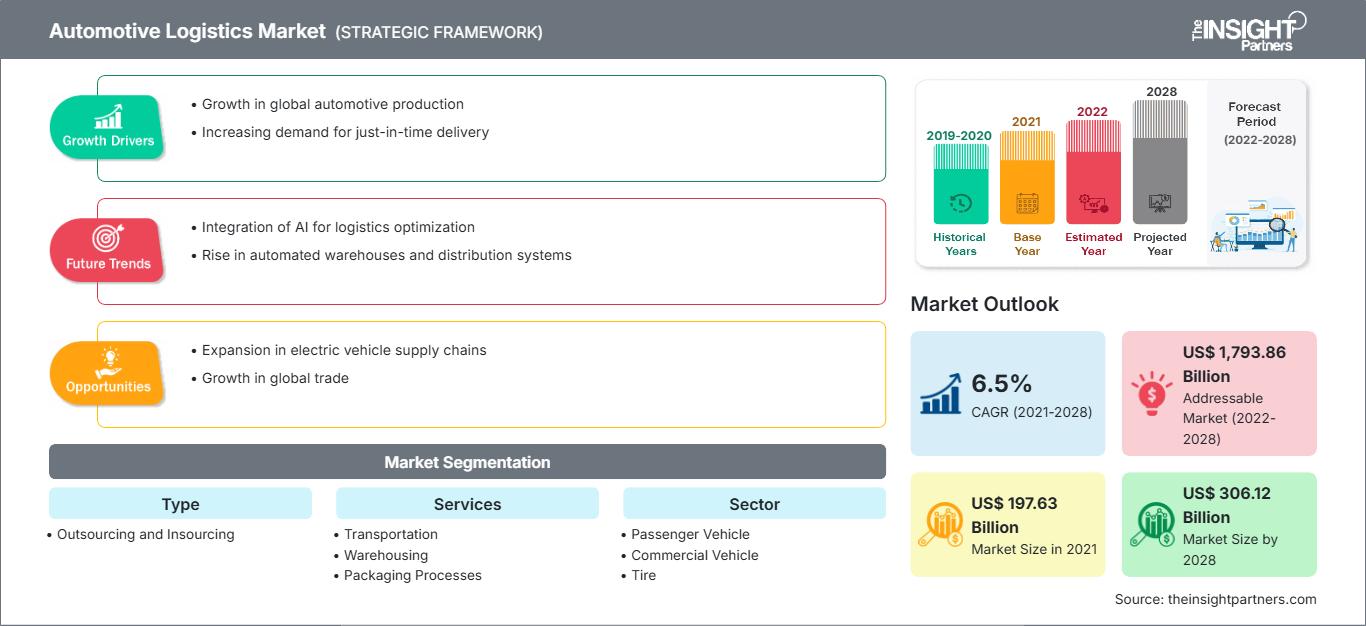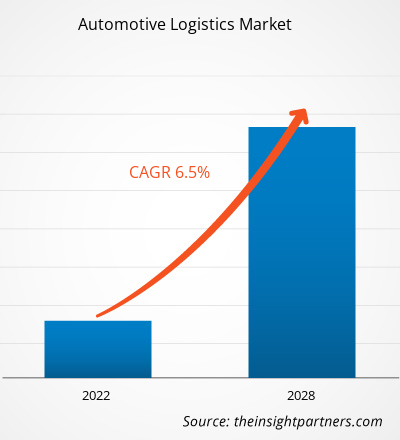[研究报告]预计汽车物流市场规模将从 2021 年的 1976.3046 亿美元增长到 2028 年的 3061.2154 亿美元;预计 2021 年至 2028 年的复合年增长率为 6.5%。
分析师观点:
汽车物流市场在整个行业中对车辆、汽车零部件和备件的高效运输发挥着至关重要的作用。它涵盖了各种专门从事汽车、整车和轿车物流的公司,提供汽车产品的运输、仓储和配送等服务。汽车物流公司负责管理汽车行业复杂的供应链。他们确保车辆从制造厂到经销商或直接到客户的无缝运输。这些公司利用其在运输和物流方面的专业知识来优化路线、最大限度地缩短交货时间并提高整体效率。汽车物流公司也专注于汽车零部件和备件的运输和配送。他们负责采购、存储以及将这些零部件运送到装配厂或维修中心的复杂任务。通过利用专门的系统和技术,汽车零部件物流公司简化了库存流程,确保在正确的时间提供正确的零部件。物流是汽车和运输行业的重要组成部分,确保该行业的平稳运行。它涵盖各种活动,包括汽车仓储、库存管理、包装和逆向物流。有效的汽车物流管理可以降低成本、提高客户满意度并提高运营效率。汽车物流市场也提供各种就业机会,包括汽车物流工作。这些职位涉及协调和监督车辆或汽车零部件的运输和交付。从管理物流运营到优化供应链流程,该领域的专业人员在确保汽车产品及时安全运输方面发挥着关键作用。由于对高效供应链管理和及时交付备件的需求不断增长,全球汽车备件物流市场正在经历显著增长。物流顾问提供专业知识和解决方案,以优化汽车零部件物流流程,降低成本并提高客户满意度。汽车零部件物流确保零部件在整个供应链中的无缝流动。相比之下,汽车物流专注于高效运输和配送汽车零部件,以满足市场需求。
市场概览:
汽车物流是指将与整车和汽车零部件相关的机械、库存和物料等资源从一个区域安排和运输到预定地点。为了满足客户需求,汽车物流需要控制商品从原产地到消费地的流动。管理公司成品和服务的日常运营是物流管理的重点。这种管理能够高效地将物品向前、向后移动并入库。对高效定制物流服务的需求已成为不同物流服务提供商之间的差异化特征,对于保持市场竞争力至关重要。物流服务公司也在整合大数据、物联网 (IoT) 和互联船舶等颠覆性技术,以改进其供应链管理系统。
这些技术有助于节省劳动力成本并消除装运延误。汽车行业的需求显著影响着市场的扩张。由于全球购买力的增强和生活水平的提高,预计未来几年汽车行业将大幅发展。由于这种生活方式的转变,新兴国家汽车销量的增长预计将在预测期内推动市场增长。此外,预计在预测期内,道路上大量现有汽车物流对汽车零配件的需求也将推动市场发展。
自定义此报告以满足您的要求
您将免费获得任何报告的定制,包括本报告的部分内容,或国家级分析、Excel 数据包,以及为初创企业和大学提供超值优惠和折扣
汽车物流市场: 战略洞察

-
获取本报告的主要市场趋势。这个免费样本将包括数据分析,从市场趋势到估计和预测。
市场驱动力:全球电子商务行业扩张推动汽车物流市场增长
电子商务行业的快速扩张已成为汽车物流领域市场增长的重要驱动力。随着消费者越来越多地转向在线平台购买汽车、汽车零部件和备件,对高效物流解决方案的需求也随之猛增。电子商务活动的激增直接影响了汽车、汽车和汽车物流公司,改变了它们的运营方式并扩大了它们的市场潜力。电子商务为汽车销售开辟了新的途径,消费者现在可以在线浏览和购买汽车。这一趋势促使开发专门的物流服务,以处理在线购买汽车的运输和交付。汽车物流公司介入以弥合在线购买和实物交付之间的差距,确保车辆安全高效地运送到买家所在地。
此外,电子商务的繁荣也刺激了在线市场对汽车零部件和备件的需求。如今,客户可以在家中舒适地订购特定的零部件和备件。这种转变催生了专门管理这些物品的仓储、包装和配送的汽车零部件物流服务。这些物流供应商利用其专业知识来简化供应链,确保及时将正确的零部件交付给客户。电子商务行业的扩张也促使汽车物流公司采用创新技术和汽车物流解决方案来提升运营效率。
先进的跟踪系统、路线优化软件和实时库存管理工具对于满足电子商务客户的需求至关重要。通过利用这些技术,汽车和轿车物流公司可以提供高效透明的服务,确保及时交付并提高客户满意度。此外,电子商务行业的增长也为汽车物流领域带来了新的就业机会。汽车物流工作,尤其是电子商务履约方面的工作,变得越来越重要。对具备管理在线订单、协调货运和优化物流运营专业知识的专业人员的需求旺盛。这一趋势导致汽车物流市场劳动力的扩张,促进了其整体增长。
细分分析:根据类型,汽车物流市场分为:
- 外包
- 内部采购
内部采购部分在 2020 年占据了最大的市场份额,而外包部分预计在预测期内将在市场上实现最高的复合年增长率。汽车物流市场中的内部采购部分占有最大的份额。这是因为汽车公司和制造商选择在内部管理其物流运营,从而使他们能够更好地控制、查看和利用现有资源。内部采购可以实现定制化、差异化以及访问实时数据和分析。虽然外包仍然发挥着一定作用,但内包的主导地位推动了汽车物流市场的整体增长。
区域分析:
2021 年亚太汽车物流市场价值 867.7 亿美元,预计到 2028 年将达到 1423.4 亿美元;预计预测期内的复合年增长率为 7.3%。亚太地区已确立了在汽车物流市场的主导地位,并成为领先的地理区域。该地区占据市场主导地位有几个关键因素,包括其强劲的汽车制造业、快速的经济增长和不断扩大的消费者群体。
首先,亚太地区拥有一些全球最大的汽车制造商和生产中心。中国、日本、韩国和印度等国家的汽车行业取得了显著增长,吸引了全球汽车制造商,并促进了大规模制造设施的建立。强大的汽车制造业催生了对汽车物流服务的巨大需求,推动了该地区的市场增长。其次,亚太地区经济的快速增长导致国内消费激增,汽车需求增加。随着该地区各国可支配收入的提高,轿车和其他交通工具的购买量大幅增加。汽车保有量的增长直接转化为对汽车物流服务的需求增加,包括汽车和汽车零部件的运输、仓储和配送。此外,亚太地区不断扩大的消费群体在市场主导地位中发挥着关键作用。该地区人口超过 46 亿,为汽车制造商和供应商提供了庞大的客户群。中国和印度等国家中产阶级的崛起和城市化进程的加快,创造了庞大的汽车市场。汽车需求的增长需要高效可靠的汽车物流服务,以确保及时交付并满足消费者的期望。此外,亚太地区积极在物流运营中采用先进技术和数字化。随着电子商务的兴起以及供应链管理系统、实时跟踪和数据分析等技术驱动解决方案的整合,该地区汽车物流服务的效率和效益得到了提升。
这项技术进步进一步巩固了亚太地区的市场主导地位。政府在基础设施建设方面的举措和投资也为该地区的市场主导地位做出了贡献。亚太地区各国一直在积极投资交通基础设施,包括公路网络、港口和铁路系统,以支持不断发展的汽车工业。这些基础设施的发展促进了无缝运输和高效的物流运营,使该地区成为汽车制造和物流活动的理想中心。
北美汽车物流市场凭借强大的行业影响力和先进的物流基础设施,在汽车物流市场中占据重要地位。在北美,汽车和汽车物流公司受益于成熟的汽车制造业、强大的交通网络以及对技术进步的重视。北美拥有主要的汽车制造商和蓬勃发展的汽车市场,主要参与者分布在美国、墨西哥和加拿大。这些公司对汽车物流服务的需求巨大,包括车辆及汽车零部件的运输、仓储和配送。
知名汽车制造商和供应商的存在推动了该地区汽车物流市场的增长。在交通基础设施方面,北美拥有广泛的公路网络、铁路系统和四通八达的港口。这些基础设施促进了车辆和汽车零部件的高效运输和配送,使汽车物流公司能够优化物流运营。该地区的交通基础设施确保了及时交付,实现了具有成本效益的运营,并支持了汽车物流市场的整体增长。此外,北美重视物流行业的技术进步,重点是数字化和自动化。该地区的汽车物流公司利用供应链管理系统、实时跟踪和数据分析等尖端技术来提高运营效率并提供卓越的客户服务。通过采用这些先进的解决方案,北美的汽车物流公司优化了库存管理,简化了运营流程,并提高了整体供应链的可视性。
此外,北美见证了电子商务在汽车行业日益增长的重要性。汽车销售和汽车零部件分销线上平台的兴起刺激了对专业物流服务的需求。北美的汽车物流公司顺应这一趋势,开发了定制化解决方案,用于运输和配送通过电商平台购买的车辆和汽车零部件。对电商物流的关注进一步推动了该地区汽车物流市场的增长。政府的政策和举措也有助于深入了解北美汽车物流市场。美国、墨西哥和加拿大政府已采取措施支持汽车行业并加强物流基础设施建设。这些措施包括投资交通基础设施、促进跨境贸易协定以及营造有利于汽车制造和物流运营的环境。
汽车物流市场区域洞察
The Insight Partners 的分析师已详尽阐述了预测期内影响汽车物流市场的区域趋势和因素。本节还讨论了北美、欧洲、亚太地区、中东和非洲以及南美和中美洲的汽车物流市场细分和地理位置。
汽车物流市场报告范围
| 报告属性 | 细节 |
|---|---|
| 市场规模 2021 | US$ 197.63 Billion |
| 市场规模 2028 | US$ 306.12 Billion |
| 全球复合年增长率 (2021 - 2028) | 6.5% |
| 历史数据 | 2019-2020 |
| 预测期 | 2022-2028 |
| 涵盖的领域 |
By 类型
|
| 覆盖地区和国家 |
北美
|
| 市场领导者和主要公司简介 |
|
汽车物流市场参与者密度:了解其对业务动态的影响
汽车物流市场正在快速增长,这得益于终端用户需求的不断增长,而这些需求的驱动因素包括消费者偏好的不断变化、技术进步以及对产品优势的认知度不断提高。随着需求的增长,企业正在扩展其产品线,不断创新以满足消费者需求,并利用新兴趋势,从而进一步推动市场增长。

- 获取 汽车物流市场 主要参与者概述
汽车物流市场分析包括 CEVA Logistics AG、DB Schenker、DSV A/S、DHL International GmbH(德国邮政 DHL 集团)、GEODIS、Kuehne + Nagel Management AG、日本通运株式会社、Ryder System, Inc.、XPO Logistics, Inc. 和联合包裹服务公司 (United Parcel Service of America, Inc.) 等参与者。在汽车物流参与者中,CEVA Logistics AG 和日本通运株式会社凭借其提供的多样化产品组合位居前两位。
最新发展:
汽车物流市场中的公司广泛采用并购等无机和有机战略。以下列出了一些近期的关键市场发展:
- 2023 年,密歇根州已获得 1300 万美元的资金,用于与戴姆勒北美卡车公司和 DTE Energy 合作开发用于电动汽车 (EV) 货运卡车的新型充电中心。
- 历史分析(2 年)、基准年、预测(7 年)及复合年增长率
- PEST和SWOT分析
- 市场规模、价值/数量 - 全球、区域、国家
- 行业和竞争格局
- Excel 数据集
近期报告
相关报告
客户评价
购买理由
- 明智的决策
- 了解市场动态
- 竞争分析
- 客户洞察
- 市场预测
- 风险规避
- 战略规划
- 投资论证
- 识别新兴市场
- 优化营销策略
- 提升运营效率
- 顺应监管趋势






















 获取免费样品 - 汽车物流市场
获取免费样品 - 汽车物流市场